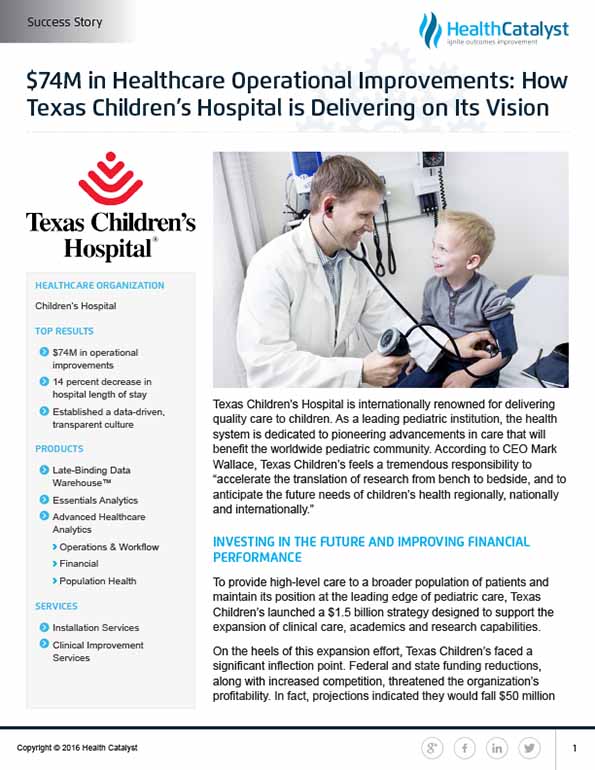Texas Children’s Hospital launched a systemwide improvement project aimed at enhancing patient accessibility and generating operational cost savings. This initiative has surpassed expectations, successfully achieving $74 million in cost savings within just 18 months.
Texas Children’s Hospital is internationally renowned for delivering quality care to children. As a leading pediatric institution, the health system is dedicated to pioneering advancements in care that will benefit the worldwide pediatric community. According to CEO Mark Wallace, Texas Children’s feels a tremendous responsibility to “accelerate the translation of research from bench to bedside, and to anticipate the future needs of children’s health regionally, nationally and internationally.”
To provide high-level care to a broader population of patients and maintain its position at the leading edge of pediatric care, Texas Children’s launched a $1.5 billion strategy designed to support the expansion of clinical care, academics and research capabilities.
On the heels of this expansion effort, Texas Children’s faced a significant inflection point. Federal and state funding reductions, along with increased competition, threatened the organization’s profitability. In fact, projections indicated they would fall $50 millionshort of what was needed to build capital reserves and to maintain their bond rating.
To improve financial performance and prepare for the future, Texas Children’s leadership team launched a system-wide performance improvement project called “Delivering on the Vision” (DOTV). DOTV would involve increasing accessibility for patients as well as driving healthcare operation savings. To achieve this vision, the health system would need to improve the quality of patient care, increase revenues and reduce costs.
Texas Children’s strategy for delivering on the vision encompassed, in part, the following efforts:
The common denominator in these efforts was a need for sustained, transparent, easily visualized data and measurement. Therefore, Texas Children’s implemented a late-binding enterprise data warehouse (EDW) platform and healthcare analytics applications from Health Catalyst. The EDW integrates data from the electronic health record (EHR), financial, operational and other systems across Texas Children’s to create an enterprise-wide, single source of truth that informs clinical and operational decisions.
The EDW delivers quick and secure access to integrated, trusted data. Analytics applications running on the EDW give clinicians and staff access to needed information via easy-to-use dashboards. Access to trusted data has enabled a culture of transparency, driving system-wide engagement and accountability for clinical and operational results.
The DOTV initiative is achieving real, measurable healthcare performance improvement.
As part of the DOTV initiative, Texas Children’s leaders established a goal of increasing operating margins over the course of 18 months with a target of $60 million in savings. The organization has far surpassed this goal, realizing $74 million in cost savings to date. These savings are the result of the systematic identification and execution of revenue generation and cost reduction improvements.
Using the EDW to complement their work, Texas Children’s continued to identify several key performance improvement opportunity areas and executes focused interventions to drive operational savings. Key initiatives and their respective success include:
An initiative to improve practice management resulted in:
A complimentary initiative to improve provider productivity achieved:
The health system undertook an initiative to use labor resources more effectively to deliver optimal patient care. Results included:
Texas Children’s care teams are proactively making the shift from fee-for-service to value-based care using evidence-based practices and data-driven decision-making. Specifically, these teams are improving quality and cost by reducing variations in care. For example, the health system’s initiative for improving asthma care achieved a 49 percent decrease in unnecessary chest X-ray orders, 80 percent utilization of best-practice order sets and 90 percent usage of asthma action plans by providers.
Texas Children’s tackled clinical documentation improvements, including more accurate and timely coding and better billing and revenue capture. The health system also achieved non-labor improvements by standardizing supplies and services and reducing non-labor supply and purchased services costs.
Texas Children’s is achieving one of its most important objectives of the DOTV initiative: improving patient access. The health system has sustained a 14 percent decrease in overall hospital length of stay two years in a row. At the same time, the census has increased, enabling physicians to see more patients. The organization’s quality improvement initiatives ensure that patients receive quality care as they transition from the hospital to the level of care they need.
The DOTV initiative—supported by data—enables more strategic decision-making and increases the accountability of leaders, providers and frontline managers for their clinical and operating performance. Physicians now have greater accountability for their performance because they are able to understand and track their performance against shared objectives. Accurate, timely, accessible data has made the conversations among medical staff and the administrative team more productive and action-oriented. And when performance issues crop up, leadership can identify them easily and intervene in a timely manner.
“Through our Delivering on the Vision initiative, we wanted to improve revenue or reduce expense by a net of $61.4 million. That was our goal, and we gave ourselves 18 months to achieve it. We have far surpassed that target. Health Catalyst’s solution has played an integral part in our ability to sustain our gains and deliver even further beyond our goal.”
– Mark Mullarkey, Senior Vice President
Texas Children’s will continue to broaden its use of healthcare analytics in support of a growing number of improvement efforts designed to achieve higher-quality care, reduced costs and a better patient experience.


